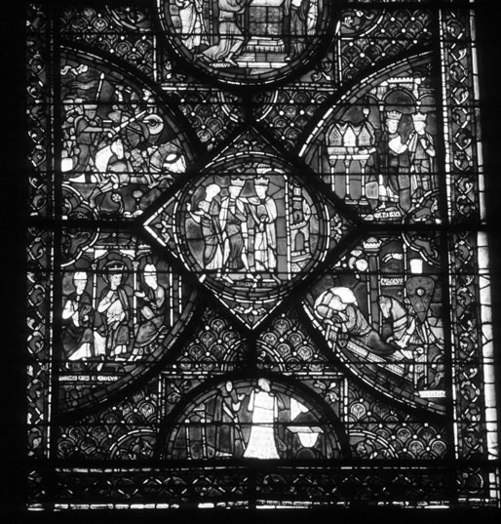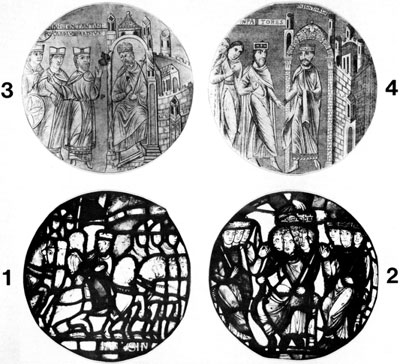An Empire of Memory (16 page)
Read An Empire of Memory Online
Authors: Matthew Gabriele
Tags: #History, #Medieval, #Social History, #Religion

why Compiègne is named after Charles the Bald.52 Hugh’s vita of St Sacerdos,
written for the monastery of Sarlat (in the Périgord) c.1107, does not mention the
Descriptio qualiter explicitly but seems to rely on it when Hugh recounts how he
had read elsewhere that Sarlat received a large piece of the True Cross from Charles,
who had brought the relic back with him from Jerusalem.53 The early twelfth-
century Gesta episcoporum Mettensium summarized the entire Descriptio qualiter up
to the death of Charlemagne, as did the early thirteenth-century Chronicon of
Martin of Troppau.54 Odo of Deuil, in describing the arrival of the Holy Tunic at
the priory of Argenteuil, used the Descriptio qualiter to explain how the relic made
its way from the East. Odo’s account, however, omitted Charles the Bald entirely.55
The entire Descriptio qualiter was included in the Vita Karoli Magni commissioned
by Frederick I Barbarossa for Charlemagne’s canonization in 116556 and can also
be found in Primat’s Roman des rois, later incorporated into the thirteenth-century
Grandes chroniques de France.57 The mid-twelfth-century Old French Le Pèlerinage
50 Hugh of Fleury, Liber de modernorum regum Francorum qui continent actus, MGH SS 9: 377.
51 This manuscript (Paris, Bib. Maz. MS 2013) is cited and discussed in Elizabeth A. R. Brown, and
Michael W. Cothren, ‘The Twelfth-Century Crusading Window of the Abbey of Saint-Denis:
Praeteritorum enim recordatio futurorum est exhibitio’, Journal of the Warburg and Courtald Institutes, 49 (1986), 14–15 n. 65. Its contents are described in detail in Jules Lair, ‘Mémoire sur deux
chroniques latines composées au XIIe siècle à l’abbaye de Saint-Denis’, Bibliothèque de l’École des
Chartes, 35 (1874), 567–8; and Auguste Molinier, Catalogue des manuscrits de la Bibliothèque
Mazarine, 4 vols. (Paris, 1886), ii. 321–3.
52 Hugh of Fleury, Historia Ecclesiastica: Fragmenta Fossatensis, MGH SS 9: 372–3. This dates to
c.1110.
53 Hugh of Fleury, Vita sancti Sacerdotis episcopis Lemovicensis, PL 163: 992. On the dating, see
Nico Lettinck, ‘Pour une édition critique de l’Historia Ecclesiastica de Hugues de Fleury’, Revue
Bénédictine, 91 (1981), 386.
54 Gesta episcoporum Mettensium, MGH SS 10: 538. It was likely written in the early 1120s under
Bishop Stephen (1120–63). Also, Martin of Troppau, Chronicon pontificum et imperatorum, MGH SS
22: 461–2.
55 The narrative is unpublished and survives in Oxford, Queen’s College, MS 348, fos. 48v–65v.
Elizabeth A. R. Brown and Thomas Waldman are currently completing an edn.
56 Vita Karoli Magni, in Die Legende, 17–93. The entire second book (of three) is devoted to
Charlemagne’s journey to Jerusalem. Charlemagne was canonized by the anti-pope Paschal III, but
Barbarossa and Pope Alexander III soon reconciled and the canonization was never formally recognized
by the Pope.
57 The section of the Grandes Chroniques concerning Charlemagne is translated in A Thirteenth-
Century Life of Charlemagne, tr. Robert Levine (New York, 1991), 70–91. A more critical edn. is Les
Grandes Chroniques de France, ed. Jules Viard, iii (Paris, 1923), 160–98.

Charlemagne’s Journey to the East
55
Figure 2.2. Scenes from the Jerusalem Crusade, Charlemagne Window, Chartres Cathedral.
Photo by Elizabeth Pastan, reprinted with permission.
de Charlemagne used the Descriptio qualiter as its primary source of inspiration.58
Even the thirteenth-century Old Norse Karlamagnús Saga used the Descriptio
qualiter, although likely filtered through the Pèlerinage.59
At Chartres, an early thirteenth-century stained-glass window, dedicated to
Charlemagne’s legendary conquests in Spain and the Holy Land, has six panels
depicting scenes from the Descriptio qualiter: Charles’s reception of the Eastern
envoys, the Byzantine ruler’s dream of Charlemagne, the defeat of the Muslims at
Jerusalem, Charles meeting the Byzantine ruler at the gates of Constantinople,
Charles receiving relics as gifts, and finally his presentation of the crown of thorns
to Aachen (Figure 2.2).60 The abbey church at Saint-Denis had a window, a mid-
twelfth-century creation, with fourteen medallions linking the Descriptio qualiter to
58 Le Pèlerinage de Charlemagne, tr. Glyn S. Burgess (Edinburgh, 1998). On the relationship
between the Descriptio qualiter and Le Pèlerinage, see Anne Latowsky, ‘Charlemagne as Pilgrim?
Requests for Relics in the Descriptio qualiter and the Voyage of Charlemagne’, in Legend of
Charlemagne, 153–67.
59 Karlamagnús Saga: The Saga of Charlemagne and his Heroes, tr. Constance B. Hieatt (Toronto,
1980), 181–205.
60 Description from Clark Maines, ‘The Charlemagne Window at Chartres Cathedral: New
Considerations on Text and Image’, Speculum, 52 (1977), 805–8. Also now see Pastan,
‘Charlemagne as Saint?’, 97–135.
56
The Franks Remember Empire
the First Crusade (Figure 2.3). The first two medallions portray generalized scenes
of crusading, the second two medallions show Charlemagne being summoned to
the East by Byzantine envoys, then meeting the Byzantine ruler at Constantinople,
and the final ten panels illustrate various scenes from the inception of the First
Crusade through the battle of Ascalon.61 By the thirteenth century one writer could
comfortably state what the Saint-Denis window had suggested––that the crusade of
1095 was actually the Second because Charlemagne had staged the First.62
As the last few examples imply, the Descriptio qualiter has been thought of as the
narrative of ‘Charlemagne’s crusade’, with the text necessarily emerging from the
contemporary experience of the First Crusade.63 These scholars have latched onto
the martial nature of Charlemagne’s journey to the East, further noting the text’s
condescension towards the Eastern empire, as well as the Byzantine call for help
to the West. Yet it seems mistaken to link the Descriptio qualiter too closely to
crusading. For example, Alexius’ call for help at Piacenza in 1095 was not the first
time he had asked the West for military assistance, having done so numerous times
between 1071 and 94. Although the Greek emperor rates below Charles in the
Descriptio qualiter, its portrayal of the Byzantine ruler is generally laudatory, very
unlike his portrayal in Einhard’s Vita Karoli and Benedict of St Andrew’s Chronicon
(let alone the narratives of the First Crusade).64
Additionally, the two most outstanding facets of crusading––Jerusalem and the
Muslims––hardly figure in the narrative at all. The emphasis the author places on
Constantinople (especially as the location of the relics Charlemagne returns with),
as well as his mention of Ligmedon, may suggest the author’s familiarity with the
contemporary practicalities of pilgrimage. However, he shows almost no interest in
the Holy Land more generally.65 Jerusalem receives barely a mention, not even a
token amount of rejoicing can be heard once Charles has rid the city of the
befouling menace that plagued it. This is a far cry from the rhetoric deployed by
Urban II, the crusaders, or their later narrators in the West.66 Moreover, the
61 Brown and Cothren, ‘Crusading Window’, 1–38.
62 Alberic of Trois-Fontaines, Chronicon, MGH SS 23: 804. The text is mid-13th cent.
63 For examples in modern scholarship, see Giosuè Musca, Carlo Magno ed Harun al Rashid (Bari,
1963), 78; and Paul Rousset, Les Origines et les caractères de la Premiére Croisade (New York, 1978), 41.
64 On Alexius and the West, see M. de Waha, ‘La Lettre d’Alexis I Comnène à Robert le Frison:
Une revision’, Byzantion, 47 (1977), 119. On Charles’s relations with the Byzantines, Descriptio
qualiter, ed. Rauschen, 110–12; Einhard, Vita Karoli, 20; Benedict, Chronicon, 711. Much hostility
towards the Byzantine empire is also found in the narratives of the First Crusade. Jonathan Riley-
Smith, The First Crusade and the Idea of Crusading (Philadelphia, 1986), 108. On East–West relations
generally, see Jonathan Harris, Byzantium and the Crusades (London, 2003); Christopher Macevitt,
The Crusades and the Christian World of the East: Rough Tolerance (Philadelphia, 2007); and Brett
Whalen, Dominion of God: Christendom and the Apocalypse in the Middle Ages (Cambridge, Mass.,
2009).
65 Folz, Souvenir, 180; Marc du Pouget, ‘Recherches sur les chroniques latines de Saint-Denis:
Édition critique et commentaire de la Descriptio clavi et corone domini et de deux séries de textes relatifs à la légende carolingienne’, Positions des thèses soutenues par les élèves de la promotion de 1978 pour obtenir le diplôme d’Archiviste Paléolgraphe, Bibliothèque de l’École des Chartes (Paris, 1978), 43.
66 There is also no mention of the Holy Sepulcher, which, Sylvia Schein argues, was the original
objective of the First Crusade. See Sylvia Schein, ‘Jérusalem: Objectif originel de la Première
Croisade?’, in Michel Balard (ed.), Autour de la Première Croisade: Actes du colloque de la Society for

Charlemagne’s Journey to the East
57
Figure 2.3. Reconstruction of lower registers of Crusading Window, Saint-Denis. Re-
printed with permission from Elizabeth A. R. Brown and Michael W. Cothren, ‘The
Twelfth-Century Crusading Window of the Abbey of Saint-Denis: Praeteritorum enim
recordatio futurorum est exhibitio’, Journal of the Warburg and Courtald Institutes, 49
(1986), 1–40.
Muslims of the Descriptio qualiter seem to be little more than straw men––nothing
but generic pagans, who are quickly swept aside by Charles and excised from the
narrative in only two sentences. The roughly contemporary Oxford Chanson de
Roland, even with all of its misconceptions about Islam, exhibits a better under-
standing of, and thoughtfulness about, the Muslims than does the Descriptio
qualiter. Although an armed expedition to Jerusalem against the Muslims is the
ostensible reason for Charlemagne’s expedition to the East, it seems more of an
excuse to get him to Constantinople and get powerful christological relics into his
hands.
Most scholars date the Descriptio qualiter to the last quarter of the eleventh
century, hinging their discussions about the Descriptio qualiter’s provenance upon a
sentence towards the end of the narrative that has Charlemagne establish the feast
of Lendit to celebrate the christological relics with which he had returned from
Constantinople.67 The narrative announces Lendit as occurring in the second week
the Study of the Crusades and the Latin East (Clermont-Ferrand, 22–25 juin 1995) (Paris, 1996),
119–26; repr. in Sylvia Schein, Gateway to the Heavenly City: Crusader Jerusalem and the Catholic
West (1099–1187) (Burlington, Vt., 2005), 9–20. The Descriptio qualiter is, however, closer in tone to Gregory VII’s ‘proto-crusade’ letters of 1074, especially in their shared focus on the Byzantines. See H. E. J. Cowdrey, ‘Pope Gregory VII’s “Crusading” Plans of 1074’, in B. Z. Kedar, H. E. Mayer, and
R. C. Smail (eds.), Outremer: Studies in the History of the Crusading Kingdom of Jerusalem (Jerusalem, 1982), 27–40; and the discussion in Ch. 5, below.
67 These scholars most prominently include Gaston Paris, Gerhard Rauschen, Robert Folz, and
Marc du Pouget. Gaston Paris, Histoire poétique de Charlemagne, 2nd edn. (Paris, 1905), 56; Rauschen,
Die Legende, 99–100; Folz, Souvenir, 179 n. 111; du Pouget, ‘Recherches’, Positions des thèses, 43; and 58
The Franks Remember Empire
of June, when the Church celebrated the Ember Days.68 Observed in the Western
